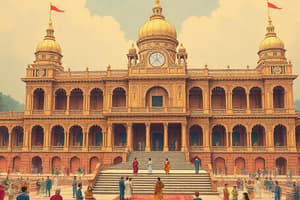Podcast
Questions and Answers
What is the primary means through which the citizens of India exercise their sovereignty?
What is the primary means through which the citizens of India exercise their sovereignty?
- Through parliament at the Centre and State Legislatures (correct)
- Through community councils
- Through elections at the local level
- Through a national referendum
Which principle ensures that every citizen in India can participate in the political system?
Which principle ensures that every citizen in India can participate in the political system?
- Political Justice
- Economic Justice
- Universal Adult Franchise (correct)
- Social Justice
What does 'One Man One Vote' signify in the context of Indian governance?
What does 'One Man One Vote' signify in the context of Indian governance?
- Women have separate voting rights
- Only men are allowed to vote
- Every person's vote carries equal weight in elections (correct)
- Votes are restricted by economic status
What is the aim of Economic Justice as described in the content?
What is the aim of Economic Justice as described in the content?
Which of the following rights are explicitly mentioned as essential for a free and civilized existence?
Which of the following rights are explicitly mentioned as essential for a free and civilized existence?
What does Social Justice aim to achieve in the Indian context?
What does Social Justice aim to achieve in the Indian context?
What is the role of the Council of Ministers in the Indian political system?
What is the role of the Council of Ministers in the Indian political system?
Which concept emphasizes the absence of arbitrary distinctions between individuals in politics?
Which concept emphasizes the absence of arbitrary distinctions between individuals in politics?
What significant event occurred on 6 December 1946 related to the Constitution of India?
What significant event occurred on 6 December 1946 related to the Constitution of India?
Who was the chairman of the Drafting Committee appointed on 29 August 1947?
Who was the chairman of the Drafting Committee appointed on 29 August 1947?
On which date was the Constitution of India officially adopted?
On which date was the Constitution of India officially adopted?
What does the Constitution of India declare India to be?
What does the Constitution of India declare India to be?
What is highlighted about the original manuscript of the Constitution of India?
What is highlighted about the original manuscript of the Constitution of India?
Which principle was laid down in the 'Objective Resolution' presented on 13 December 1946?
Which principle was laid down in the 'Objective Resolution' presented on 13 December 1946?
How long did the process of drafting the Constitution take?
How long did the process of drafting the Constitution take?
Which of the following is NOT a principle highlighted in the philosophy of the Constitution?
Which of the following is NOT a principle highlighted in the philosophy of the Constitution?
What is the primary goal of Mahatma Gandhi as described in the ideals of the preamble?
What is the primary goal of Mahatma Gandhi as described in the ideals of the preamble?
Which characteristic of the Indian Constitution indicates its adaptability?
Which characteristic of the Indian Constitution indicates its adaptability?
Which of the following features is NOT a characteristic of the Indian Constitution?
Which of the following features is NOT a characteristic of the Indian Constitution?
What reflects the federal nature of the Indian Constitution?
What reflects the federal nature of the Indian Constitution?
Which aspect of the Indian Constitution ensures equality for women?
Which aspect of the Indian Constitution ensures equality for women?
What does the term 'sovereignty' imply in the context of the Indian Constitution?
What does the term 'sovereignty' imply in the context of the Indian Constitution?
Which principle is NOT explicitly mentioned in the Preamble of the Indian Constitution?
Which principle is NOT explicitly mentioned in the Preamble of the Indian Constitution?
The Preamble serves two main functions. Which one of the following is NOT one of these functions?
The Preamble serves two main functions. Which one of the following is NOT one of these functions?
Which of the following best describes the nature of the Indian democracy as stated in the content?
Which of the following best describes the nature of the Indian democracy as stated in the content?
Which statement accurately reflects Article 51 of the Indian Constitution?
Which statement accurately reflects Article 51 of the Indian Constitution?
What does the term 'Republic' imply in the context of the Indian Constitution?
What does the term 'Republic' imply in the context of the Indian Constitution?
Which of the following objectives is associated with promoting fraternity as stated in the Preamble?
Which of the following objectives is associated with promoting fraternity as stated in the Preamble?
Which element of the Preamble emphasizes the importance of equality?
Which element of the Preamble emphasizes the importance of equality?
What should liberty be coupled with to ensure common happiness?
What should liberty be coupled with to ensure common happiness?
What does the Constitution seek to banish in order to guarantee equality?
What does the Constitution seek to banish in order to guarantee equality?
Which of the following provisions does the Constitution provide for civic equality?
Which of the following provisions does the Constitution provide for civic equality?
What does the Indian Constitution aim to achieve through universal adult franchise?
What does the Indian Constitution aim to achieve through universal adult franchise?
How does the Constitution aim to place the two sexes on an equal footing in the economic sphere?
How does the Constitution aim to place the two sexes on an equal footing in the economic sphere?
What is the envisioned goal of the Indian polity as per the Constitution?
What is the envisioned goal of the Indian polity as per the Constitution?
What does the term 'Socialism' aim to eliminate according to the Supreme Court?
What does the term 'Socialism' aim to eliminate according to the Supreme Court?
What does the Indian Constitution envision regarding property and industry?
What does the Indian Constitution envision regarding property and industry?
Study Notes
Timeline of the Indian Constitution
- The Constitution Assembly was formed on December 6th, 1946, inspired by French practices.
- The first meeting took place on December 9th, 1946, in what is now the Central Hall of Parliament House.
- Rajendra Prasad was appointed President, H.C. Mukherjee Vice-Chairman, and B.N. Rau constitutional legal advisor on December 11th, 1946.
- Jawaharlal Nehru presented the ‘Objective Resolution’ on December 13th, 1946, outlining the constitution's core principles; it later became the Preamble.
- The Objective Resolution was unanimously adopted on January 22nd, 1947.
- The national flag was adopted on July 22nd, 1947.
- India gained independence on August 15th, 1947, and was divided into the Dominion of India and the Dominion of Pakistan.
- The Drafting Committee was appointed on August 29th, 1947, with Dr. B.R. Ambedkar as Chairman and six other members.
- The Constitution of India was passed and adopted by the assembly on November 26th, 1949.
- The last meeting of the Constituent Assembly took place on January 24th, 1950, with the Constitution being signed and accepted.
- The Constitution of India came into effect on January 26th, 1950, consisting of 395 Articles, 8 Schedules, and 22 Parts.
Features of the Indian Constitution
- The Constitution was originally written in Hindi and English.
- It is the longest constitution in the world.
- It was handwritten by Prem Behari Narain Raizada.
- Each page was decorated by artists from Shantiniketan.
- The original copies are stored in special cases in the Library of the Parliament of India.
- India is declared a Sovereign, Socialist, Secular, and Democratic Republic.
Philosophy of the Constitution
- The Constitution's philosophy is based on the Objectives Resolution presented by Pandit Nehru on January 22nd, 1947.
- The Preamble summarizes the Constitution's aims and objectives.
- It emphasizes the following:
- Independent and Sovereign: India is recognized as a fully independent nation, endowed with the authority to enact laws and regulations on a wide range of subjects, including social, economic, and political matters. This autonomy ensures that India is not constrained or influenced by any foreign powers or entities, thereby allowing the government to reflect the aspirations and needs of its citizens without external interference.
- Republic: All power originates from the people of India, and there is no subordination to any external authority.
- Democracy: India operates as a representative democracy with a government formed by elected officials, ensuring a system of "Government of the people, by the people, for the people".
- Justice: The Constitution promotes social, economic, and political justice to eliminate inequality and create a fair society for all.
- Liberty: Citizens have the right to freedom of thought, expression, belief, faith, and worship.
- Equality: The principle of equality is fundamental in ensuring that all individuals, regardless of their background, have equal rights and opportunities. This entails the elimination of discrimination based on factors such as caste, creed, gender, or socioeconomic status. The Constitution of India aims to promote equality by guaranteeing that every citizen is treated fairly and justly under the law, fostering an inclusive society where everyone can participate fully in the democratic process. The Constitution ensures equality of status and opportunity, prohibiting discrimination based on religion, race, caste, sex, or place of birth.
- Fraternity promotes social, economic, and political justice, aiming to eliminate inequality and create a fair society. It emphasizes liberty, equality, and the elimination of discrimination based on background, ensuring fair treatment for all citizens.: The concept of fraternity emphasizes the importance of a sense of brotherhood and solidarity among all members of society. It encourages individuals to foster an environment of mutual respect, collaboration, and support, regardless of their differences. This principle highlights the need for unity and collective responsibility in ensuring that every person feels included and valued. Fraternity promotes social cohesion and harmony, breaking down barriers that may exist due to divisions such as religion, ethnicity, or socio-economic status, thereby contributing to a peaceful and just society.: It promotes unity and integrity among all citizens, assuring the dignity of the individual.
- Socialism: Aims to reduce inequality and provide a decent standard of life for all working people.
Outstanding Features
- The Indian Constitution is a compilation of ideas from various sources.
- It has been supplemented by numerous amendments.
- It is the longest known constitution.
- Includes detailed administrative provisions.
- Addresses the unique issues facing India.
- Includes the constitutions of individual states.
- Contains special provisions for Jammu and Kashmir, Nagaland, Sikkim, etc.
- Elaborates on federal relations.
- Encompasses both justiciable and non-justiciable rights: Fundamental Rights, Directive Principles of State Policy, and Fundamental Duties.
- Offers greater flexibility than rigidity.
- Recognizes the importance of legislation in supplementing the Constitution.
Studying That Suits You
Use AI to generate personalized quizzes and flashcards to suit your learning preferences.
Related Documents
Description
This quiz explores the important milestones in the formation and adoption of the Indian Constitution. From the initial meetings of the Constituent Assembly to the adoption of the Constitution, each event played a crucial role in shaping India's democratic framework. Test your knowledge on these key historical events.




